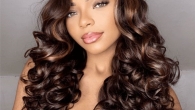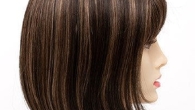
How to Protect Edges When Wearing Wigs?
Wearing wigs can be a fantastic way to enhance your style and versatility. However, one common concern among wig wearers is protecting their natural hair edges from damage. Constant friction between the wig and hairline can lead to breakage, thinning, and irritation. This guide will provide you with effective tips and techniques to safeguard your edges while rocking your favorite wigs.
Understanding Edge Damage
Before diving into prevention methods, it’s essential to understand the root causes of edge damage. Constant friction between the wig and hairline, often exacerbated by moisture and product buildup, can lead to breakage, thinning, and irritation.

- Friction: Repeated rubbing from the wig’s cap or synthetic fibers can weaken hair strands, causing them to break.
- Moisture: Sweat and humidity create a damp environment that softens hair, making it more susceptible to damage. Additionally, excessive moisture can lead to fungal infections and scalp irritation.
- Product Build-Up: The accumulation of hair products, oils, and sweat at the hairline can clog pores, hinder hair growth, and create a breeding ground for bacteria.
By recognizing these factors, you can take proactive steps to protect your edges and maintain healthy hair growth.
Preparing Your Hair for Wig Wear
- Moisturize Your Hairline: Keep your hairline hydrated with a lightweight moisturizer to protect it from dryness.
- Protective Styles: Consider protective styles like braids or twists to minimize manipulation and protect your edges.
- Hairline Cleansers: Use gentle cleansers to remove product buildup and keep your hairline clean.
Wig Care and Maintenance
- Wig Cap: Invest in a high-quality wig cap to create a barrier between your hair and the wig.
- Wig Fit: Ensure your wig fits properly to minimize friction and pressure on your hairline.
- Wig Material: Opt for wigs made with breathable materials to reduce sweat buildup.
- Wig Cleaning: Regularly clean your wig to prevent product buildup and bacteria growth.
Edge Protection Techniques
- Edge Bands: Use edge bands or protective strips to create a barrier between your hairline and the wig.
- Baby Hair Styling: Style baby hairs away from your hairline to reduce friction.
- Loose Styles: Avoid tight hairstyles that pull on your edges.
- Hairline Detangler: Gently detangle your hairline with a soft-bristled brush.
Haircare Routine for Wig Wearers
- Deep Conditioning: Regularly deep condition your hair to maintain moisture and strength.
- Low Manipulation: Limit styling and heat styling to minimize damage.
- Protective Styles: Incorporate protective styles into your haircare routine.
- Scalp Care: Keep your scalp clean and healthy to support hair growth.

Additional Tips for Edge Protection
- Wig Breaks: Give your hair a break from wigs by wearing your natural hair occasionally.
- Hair Growth Supplements: Consult with a healthcare professional about potential supplements to promote hair growth.
- Patience: Healing damaged edges takes time, so be patient and consistent with your haircare routine.
Wig Grips and Edge Protectors: A Closer Look
While general care and maintenance are crucial for protecting your edges while wearing wigs, specific products can offer targeted solutions.
Wig Grips
Wig grips have become increasingly popular as a protective measure. They are typically headbands made from soft, non-slip materials like velvet or microfiber. Here’s how they work:
- Protection: Wig grips create a barrier between the wig and your hairline, reducing friction.
- Security: They help to keep the wig in place, preventing it from shifting and pulling on your edges.
- Comfort: Many wig grips are designed to be comfortable to wear for extended periods.
Edge Protectors
Edge protectors are specifically designed to shield your hairline from damage. They come in various forms, including:
- Edge Bands: These are thin, adhesive strips that create a protective barrier along your hairline.
- Edge Gels: Gels or serums can be applied to the hairline to create a protective layer.
- Silk Scarves: Wrapping a silk scarf around your hairline can provide both protection and moisture.
Choosing the Right Product
The best edge protection product for you will depend on your hair type, wig style, and personal preference. Consider the following factors:
- Hairline Sensitivity: If you have sensitive skin, opt for gentle, hypoallergenic products.
- Wig Style: Some wig styles may require specific types of edge protection.
- Comfort: Choose products that are comfortable to wear for extended periods.
Wig-Related Hair Loss: Prevention and Treatment
While wigs offer a versatile and stylish option for many, improper care or wearing them too tightly can lead to hair loss, particularly around the hairline. This condition, often referred to as traction alopecia, occurs when continuous pulling or tension is applied to the hair follicles. Symptoms include hair thinning, breakage, and even bald patches.
To prevent wig-related hair loss, it’s crucial to prioritize proper wig care, gentle handling, and regular scalp maintenance. By understanding the factors contributing to this issue and implementing preventive measures, you can enjoy the benefits of wig-wearing without compromising the health of your natural hair.
Understanding Wig-Related Hair Loss
Traction alopecia occurs when continuous pulling or tension is applied to the hair follicles. In the case of wig wearers, this tension can come from the wig itself or from the way the wig is secured. Symptoms include hair thinning, breakage, and even bald patches around the hairline.

Preventing Wig-Related Hair Loss
- Proper Wig Fit: Ensure your wig fits correctly and comfortably. A wig that is too tight can exert excessive pressure on your hairline.
- Gentle Handling: Avoid pulling or tugging on your wig to prevent strain on your hair.
- Wig Breaks: Give your scalp and hair a rest by taking breaks from wearing wigs.
- Scalp Care: Maintain a healthy scalp by keeping it clean and moisturized.
- Hair Protection: Consider protective hairstyles or using a wig cap to minimize friction between the wig and your hair.
Treating Wig-Related Hair Loss
If you’ve already experienced hair loss due to wig wear, it’s essential to take steps to promote hair regrowth:
- Consult a Dermatologist: A dermatologist can diagnose the extent of hair loss and recommend appropriate treatments.
- Gentle Hair Care: Avoid harsh chemicals and heat styling, as these can further damage your hair.
- Scalp Massage: Stimulate blood flow to the scalp by gently massaging the area.
- Hair Growth Products: Consider using over-the-counter hair growth products or consulting with a dermatologist for prescription options.
- Patience: Hair growth takes time, so be patient and consistent with your hair care routine.
Choosing the Right Wig
Selecting the right wig is crucial for preventing hair loss and ensuring optimal comfort. Look for wigs that:
- Fit Properly: Ensure the wig is the correct size and doesn’t feel too tight. A snug fit can cause undue pressure on your hairline, leading to breakage and discomfort.
- Are Made of Breathable Materials: Opt for wigs constructed from breathable fabrics to allow your scalp to breathe and prevent moisture buildup. This helps maintain a healthy scalp environment.
- Have a Comfortable Cap Construction: Choose wigs with caps that minimize pressure on your hairline. Look for soft, cushioned caps that distribute weight evenly and reduce friction.
By carefully considering these factors, you can select a wig that not only complements your style but also protects the health of your natural hair.
Nurturing Your Edges and Rocking Your Wigs
Protecting your edges while wearing wigs requires dedication and care. By following these tips and incorporating them into your routine, you can maintain healthy edges and confidently rock your favorite wigs. Remember, consistency is key, so be patient and persistent in your efforts.
A healthy hairline is the foundation for stunning hairstyles, whether natural or enhanced with wigs. Invest time and effort into protecting your edges, and you’ll reap the rewards of strong, beautiful hair. With proper care, you can enjoy the versatility of wigs without compromising the health of your natural hair.












Leave a Reply